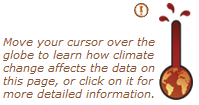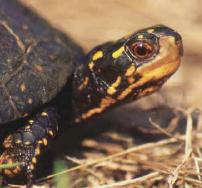Mosaic Habitats
Turtles and Grouse Bats

Some of Connecticut's wildest residents do not restrict themselves to one particular type of habitat; in fact, they can't. They live among mature forest trees some of the time but at other times require fields, young forests, shrublands or, in many cases, clean waterways for their continued existence. If this mosaic of habitats is fragmented with roads and other intrusions, these species will decline. To track the condition of these productive mosaics in Connecticut, the Council selected three types of animals that depend on them: turtles, grouse and bats.
Resident Turtles

Five of the eight turtle species that live year-round in Connecticut are on the latest list of species that are endangered or of special concern.

Turtles are excellent indicators of ecological health. They live long lives, reproduce slowly and decline in number when their habitat declines. This indicator includes the eight species of turtle that live in Connecticut (but not the four marine species that visit Long Island Sound in summer, all of which also are threatened or endangered).
Until 2015, only three of the eight resident turtle species were listed as endangered or of special concern: bog turtle (endangered), eastern box turtle and wood turtle (both species of special concern and particularly representative of mosaic habitats). The other five -- common musk turtle, common snapping turtle, northern diamondback terrapin, eastern painted turtle and spotted turtle -- were considered stable and secure enough to be kept off the list.
The 2015 list classified two more species as being of special concern: northern diamondback terrapin and spotted turtle. Classification and protection of endangered species in Connecticut dates back to 1989 and the adoption of "An Act Establishing a Program for the Protection of Endangered and Threatened Species" (Public Act 89-224). The Department of Environmental Protection published the first list of Connecticut's Endangered, Threatened and Special Concern Species in 1992. At that time, only the bog turtle was on the list. The wood turtle and the eastern box turtle joined the list in 1998 as species of special concern.
The Goal for Turtles
The goal for all endangered and threatened species is for recovery of their populations to a stable, sustainable level.
Ruffed Grouse

The Ruffed Grouse population recovered slightly after declining to its lowest level in decades.

The chart illustrates a dramatic decline in Ruffed Grouse (Bonasa umbrellas). The annual index value is the mean of population counts from the Christmas Bird Count and Summer Bird Count. A similar decline in the Ruffed Grouse population has been documented by the Department of Energy and Environmental Protection from actual observations by turkey hunters over a ten year period.
Once prevalent throughout the state, this game bird is rarely seen outside the northwest corner, where it also is uncommon. The most likely cause is a decline in young forests, worsened by the effects of human activities including roads, development and introduction of invasive species and pests that have reduced the vegetation favored by grouse. Too many deer reduced the forest understory where the grouse lived.
Grouse is an excellent indicator species for New England hardwood-dominated forested landscapes. Grouse have well-defined habitat requirements: multiple stages of forest including newly disturbed forest, shrub openings and mature stands, all within a 15 to 40 acre area. Much like terrestrial turtles, grouse are sensitive to habitat fragmentation. They are readily detected and recorded, and do not migrate.
The mosaic habitats that support Ruffed Grouse also sustain many other species such as American woodcock, New England cottontail, and numerous songbirds. While 60 percent of Connecticut is forested, the Connecticut Department of Energy and Environmental Protection estimates that only five percent contains the early-stage forest that grouse depend upon. Recent efforts to create young forest habitat might be one reason for the slight increase in sightings since 2015.
The Goal for Grouse
The Association of Fish and Wildlife Agencies, of which Connecticut's DEEP is a member, prepared a plan in 2006 that set a target of restoring the Ruffed Grouse throughout North America to 1980 population levels by 2025.
.jpg?h=455&w=300&sc_lang=en&hash=5F8B391AEB75B650A3BECC06AD2FB20D) *The CEQ Ruffed Grouse Index is based on the mean of winter and summer bird counts conducted by volunteers. This index is the CEQ's first use of these extensive troves of data collected by the National Audubon Society and its affiliated organizations. The scale of the index value is set by the CEQ; a value of 100 equals the highest population level detected over the 20 years shown on the chart. The Council is grateful to the organizations and individuals who provided data and advice for creating this new index.
*The CEQ Ruffed Grouse Index is based on the mean of winter and summer bird counts conducted by volunteers. This index is the CEQ's first use of these extensive troves of data collected by the National Audubon Society and its affiliated organizations. The scale of the index value is set by the CEQ; a value of 100 equals the highest population level detected over the 20 years shown on the chart. The Council is grateful to the organizations and individuals who provided data and advice for creating this new index.



